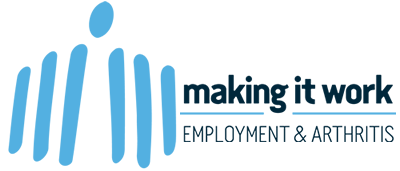Making it WorkTM Program
Arthritis and musculoskeletal conditions are the leading cause of long-term work disability with a major impact on a person’s quality of life at work and at home. There are few resources or services that address the impact of arthritis on employment. The Making it WorkTM on-line program has been specifically designed for this reason.
What is the Making it WorkTM?
It is an on-line self-management program to support people with inflammatory types of arthritis to remain employed and lead healthy and productive lives at work.
Who is the Making it WorkTM for?
People with inflammatory types of arthritis (for example, rheumatoid arthritis, psoriatic arthritis, lupus, ankylosing spondylitis, connective tissue diseases, and other spondyloarthropathies) who are concerned about their work and would like to learn strategies to help them remain employed.
Program Description
This program takes 10 weeks to complete. You can do this in the comfort of your own home.
The components include:
- Individual interactive eLearning modules. The program offers 5 interactive modules for you to complete online on your own time (approximately one to two hours each), covering topics such as work and arthritis; management of inflammatory arthritis; disclosing diagnosis of arthritis at work; dealing with fatigue and stress at work; effective communication strategies; legal issues around employment, disability, and job accommodations; optimizing interpersonal relationships at work; ergonomics for your work environment and obtaining job accommodations.
- Online video group meetings. There are 5 online video group meetings facilitated by a trained facilitator lasting 1.5 - 2 hours each. They are held every other week after you have completed the corresponding eLearning module. You will meet other people like yourself and have the opportunity to discuss arthritis and work-related issues, share experiences, and practice skills you learn in the program.
- Two on-line consultations with health professionals. An occupational therapist (OT) will conduct an online ergonomic assessment of your work environment and your work tasks. Following this, you will have an on-line consultation with a Vocational Rehabilitation Counsellor (VRC) who will provide you with employment counselling, work retention strategies, and other resources.
Technical requirements
- Online modules are compatible with Windows or Mac; or tablet. A cell phone does not provide a large enough screen for optimum viewing.
- A webcam is required for the video group meetings
Program Goals and Objectives
- Improve your ability to perform your work
- Help you remain employed for as long as you wish.
- improving your confidence in your ability to work with arthritis
- improving your confidence and your ability to manage problems at work because of your arthritis
- helping you identify and change the things that make it hard for you to work or put you at risk of having to stop work because of your arthritis.
- improving your confidence and your ability to request and obtain job accommodations


Program Content
The content and activities of this program have been designed to provide you with knowledge, skills and practice so you are better prepared to handle the challenges of living and working with arthritis. Activities will increase your self-awareness so you understand better how your arthritis affects your ability to work. The program also provides you with tools and strategies to help you take action and make the changes you feel are necessary.
Throughout this program you will learn:
- A problem-solving and goal-setting technique to solve problems and to make changes.
- The ways fatigue may affect you and ways to manage it at work.
- The way stress may affect you and ways to reduce it at work.
- Different communication strategies to help you talk with your employer and co-workers to build support and get your needs met at work.
- Your legal rights and your employer’s legal obligations about disclosure, job accommodations, and human rights.
- Ways to improve your ability to ask your employer/supervisor for changes in your job to better adapt it to your arthritis.
- The basic principles of ergonomics—how equipment and furniture can be arranged for comfort and efficiency—and apply them to your work situation.
Why was Making it Work Developed?
Arthritis is the most common health reason why Canadians have to stop working. This can have tremendous consequences to people with inflammatory arthritis and their families, financially and in terms of personal well-being. People with arthritis must deal with daily pain, stiffness and fatigue which can make working difficult. Despite the importance of this problem, there are few services available to people with arthritis to help them deal with employment issues. The program was developed to address this need.


How was Making it Work created?
To make sure the program would meet the needs of people with arthritis, we started by asking people with arthritis about the problems they experienced at work because of their arthritis. We also asked them what they felt would be helpful. This program specifically tackles problems and solutions that people like you identified.
Our program is evidence-based. The content was developed to address what is known to increase the risk of becoming work disabled—unable to work because of arthritis. This information comes from studies of arthritis and employment. As well as facts from research, we have drawn on the experience of programs already shown to be effective. Finally, we have drawn on the expertise of a team of health care and employment professionals and people with arthritis.



